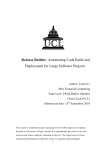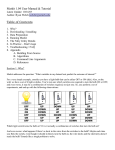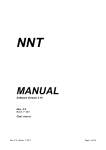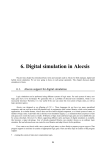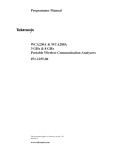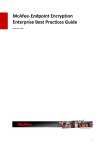Download Database Documentation
Transcript
Database Documentation
Date:
05-June-2011
From:
Bernd Plumhoff, www.sulprobil.com
Subject:
System and User Manual for Database
Table of Contents
1. SUMMARY
2
2. SYSTEM DOCUMENTATION
2
3. USER DOCUMENTATION
3
3.1 Super User with Read/Write Access
3
3.2 Normal User with Read-Only Access
4
4. APPENDIX
5
4.1 Database Definition
5
4.2 Write Interface to Database (via stored procedure & Excel)
9
4.3 Read Interface from Database (via stored procedure & Excel)
www.sulprobil.com
Printed: 6/7/2011 3:55 AM
11
Page 1/12
1. Summary
This database was implemented to
• Support selected processes with a simple “central” data repository
• Get rid of individual spreadsheets which have to be maintained with high effort
• Simplify the task of data retrieval and of data storage
• Enable additional calculations over defined periods of time and “slice & dice” calculations
• Precisely define user or process access rights
This database is a simple all-purpose database. After the initial setup there is no further need for database table
maintenance or index maintenance (apart from deleting old records to avoid the database becoming too big).
Limitations:
• The database is not designed for mass storage – you are advised to define a regular data deletion
(maintenance) procedure for each new field / data you regularly add to this database
• The design is simple and field orientated. There is no support for curves or for surfaces – which means
you cannot store nor retrieve curves or surfaces in one go. All points would have to be dealt with
individually. This is possible but it creates quite an overhead to the database engine. So if this needs to be
used it should only be temporary and not for mass storage
• Fields are stored as string values. The user needs to convert all data into the required data types
There are 3 levels of access or responsibilities:
• Technology and help desk support – After initial setup the database is backed up on a daily basis, repair
or restore can be done within two hours, new users with read or read/write access can be introduced or
old users can be deleted within 24h
• Super user with read/write access – YOU define new fields and feeds the database with approved rate
sources
• Other Users with read-only access
YOU are the owner of this database.
2. System Documentation
Technology is responsible for the database setup, user setup and for repair or restore of the database. And
Technology has to ensure that this database is up and running with a monthly average availability of 99% during
normal working hours. New users with read-only or read/write access can be introduced or old users can be
deleted within 24h.
Since YOU are the owner of this database, all access right changes have to be approved by YOU. Currently only
YOU should have read/write access to the database.
For setup details refer to the Appendix, Database Definition. Please notice that the database consists of only two
tables and two stored procedures. The two stored procedures provide a sophisticated write and read access to the
database. Since they are stored on the server side the client (user) does not need to invest a big effort but he can
easily make use of them. The database structure is not intended to change over time. This means that the
database maintenance effort is reduced to a possible minimum: Only if the database gets too big old records will
have to be deleted. If the write access user (YOU) defines a regular maintenance procedure which deletes old
data records for all fields which are regularly added to the database the effort on top of this should be zero.
Please notice: Technology should be able to rebuild or to recreate this database within two hours. This includes
corruption of database indices.
www.sulprobil.com
Printed: 6/7/2011 3:55 AM
Page 2/12
3. User Documentation
The access structure to the database is fairly simple: There is a class of super users with write access. This is
restricted to YOU only.
3.1 Super User with Read/Write Access
YOU are the owner and the only user with write access to the database. This can be reflected by a relevant AD
group. This is not intended to be enhanced for other super users. YOU are responsible for all field definitions and
for all feeds into the database. Later we might need to delete old unnecessary records, too. YOU are the only
party to approve additional users or super users.
Please notice the limitations of this database:
• The database is not designed for mass storage
• The design is simple, field orientated. There is no support for curves or for surfaces – which means you
cannot store nor retrieve curves or surfaces in one go. All points would have to be dealt with individually.
This is possible but it creates quite an overhead to the database engine. So if this needs to be used it
should only be temporary and not for mass storage
• Fields are stored as string values. The user needs to convert all data into the required data types
For the Excel write interface into the database refer to Appendix, Write Interface to Database.
These applications are feeding the database (Example):
No
1
2
3
4
5
6
7
8
Application
Load_DB
Load_DB
Load_DB
Load_DB
Load_DB
Load_DB
Load_DB
Load_DB
Source
Xtrakter
Xtrakter
Xtrakter
Xtrakter
Xtrakter
Xtrakter
Markit
Markit
www.sulprobil.com
Field
PRICE_MID
QUOTE_ASK
QUOTE_BID
NbMktMkr
TrdBandLow
VolData
CompositePrice
Depth
Frequency
Daily
Daily
Daily
Daily
Monthly
Monthly
Daily
Daily
Comment
Number of Market makers
Minimal number of trades
Trade volume (local ccy)
All Markit data older than 60 days gets deleted
Number of price providers, All Markit data older than 60 days gets deleted
Printed: 6/7/2011 3:55 AM
Page 3/12
3.2 Normal User with Read-Only Access
For the Excel read interface from the database refer to Appendix, Read Interface from Database. This can be
reflected a the relevant AD group.
Examples to retrieve static information:
The Excel function call
=sb_get_param("BPIZC610","PX_CLOSE_1D","20110121","RILO")
would result in
29.205
Please note that this value is a string value! In order to get a number of type double you would need to convert the
result yourself, for example:
=--sb_get_param("BPIZC610","PX_CLOSE_1D","20110121","RILO")
The Excel function call
=sb_get_param("FR0010850719","SECURITY_NAME","19000101","Bloomberg")
would result in
COFP4.379 02/17
Static data is stored with the date 1-Jan-1900. Please notice that the database would also have returned this
result if you had called it with a younger date than that. This is because the sb_get_param function returns the
youngest entry which is older or equal to the request date. You would need to use the sb_get_paramarray function
to retrieve the complete database record (date included) to check the exact date of the returned value.
Example to retrieve market (dynamic) data:
The Excel function call
=sb_get_param_array("US172967EZ03","PRICE_MID","20101223","Xtrakter")
would result in
{"US172967EZ03","PRICE_MID","Xtrakter",40535,"102.172"}
Here 40535 is the numerical date of 23-Dec-2010.
www.sulprobil.com
Printed: 6/7/2011 3:55 AM
Page 4/12
4. Appendix
4.1 Database Definition
CREATE TABLE [dbo].[param] (
[identifier] [varchar] (100) COLLATE SQL_Latin1_General_CP1_CI_AS NULL ,
[param] [varchar] (100) COLLATE SQL_Latin1_General_CP1_CI_AS NULL ,
[source] [varchar] (30) COLLATE SQL_Latin1_General_CP1_CI_AS NULL ,
[fromDate] [datetime] NULL ,
[toDate] [datetime] NULL ,
[value] [varchar] (500) COLLATE SQL_Latin1_General_CP1_CI_AS NULL ,
[updTime] [datetime] NULL
) ON [PRIMARY]
GO
CREATE TABLE [dbo].[param_details] (
[source] [varchar] (50) COLLATE SQL_Latin1_General_CP1_CI_AS NULL ,
[param] [varchar] (100) COLLATE SQL_Latin1_General_CP1_CI_AS NULL ,
[idYN] [char] (1) COLLATE SQL_Latin1_General_CP1_CI_AS NULL ,
[rename] [varchar] (100) COLLATE SQL_Latin1_General_CP1_CI_AS NULL ,
[priority] [int] NULL ,
[inputYN] [char] (1) COLLATE SQL_Latin1_General_CP1_CI_AS NULL
) ON [PRIMARY]
GO
CREATE UNIQUE INDEX [param_pk] ON [dbo].[param]([identifier], [param], [toDate], [fromDate], [source]) ON
[PRIMARY]
GO
CREATE INDEX [param_val] ON [dbo].[param]([param], [value], [identifier], [toDate]) ON [PRIMARY]
GO
SET QUOTED_IDENTIFIER ON
GO
SET ANSI_NULLS ON
GO
CREATE proc get_param
@identifier
@param
@source
@dated
as
if @identifier > ''
begin
select
from
where
union
select
from
where
varchar(100),
varchar(100),
varchar(30),
datetime
identifier, param, source, fromDate, value
param
identifier = @identifier
and param like isnull( @param,param )
and source like isnull( @source,source )
and (
@dated >= fromDate
and @dated < isnull( toDate, '1 jan 3000' )
or @dated is null and toDate is null )
identifier, param, source, fromDate, value
param
identifier = @identifier
and param like isnull( @param,param )
and source like isnull( @source,source )
and fromDate is null
end
www.sulprobil.com
Printed: 6/7/2011 3:55 AM
Page 5/12
else
begin
select
from
where
union
select
from
where
identifier, param, source, fromDate, value
param
param like isnull( @param,param )
and source like isnull( @source,source )
and (
@dated >= fromDate
and @dated < isnull( toDate, '1 jan 3000' )
or @dated is null and toDate is null )
identifier, param, source, fromDate, value
param
param like isnull( @param,param )
and source like isnull( @source,source )
and fromDate is null
end
GO
CREATE procedure [dbo].[set_param]
@identifier
varchar(100),
@param
varchar(100),
@source
varchar(30),
@dated
datetime,
@value
varchar(500),
@stopLoop
char(1) = 'n'
as
set nocount on
declare @vf
@vt
@rename
@priority
datetime,
datetime,
varchar(100),
int
-- ignore if bad params
if
isnull( @param,'' ) = ''
or isnull( @identifier,'' ) = ''
or isnull( @value,'' ) = ''
or isnull( @source,'' ) = ''
or @value like '#N/A%'
or @value ='?'
begin
return
end
select
from
where
@rename = rename,
@priority = priority
param_details
source = @source
and param = @param
and @stopLoop = 'n'
if @rename > ''
begin
if not exists(
-- an existing value from a higher priority source
select 1
from
param p1
where p1.identifier = @identifier
and p1.toDate is null
and p1.fromDate >= @dated
and p1.param in (
select param
from
param_details
www.sulprobil.com
Printed: 6/7/2011 3:55 AM
Page 6/12
where
source=@source
and rename = @rename
and param != @param
and priority < @priority ) )
begin
exec set_param @identifier, @rename, @source, @dated, @value, 'y'
end
end
if @source = 'input'
begin
select @dated = getdate()
end
-- if static value (ie not time dependant)
if @dated is null
begin
-- if value unchanged then return
if exists(
select 1
from
param
where identifier = @identifier
and param = @param
and source = @source
and value = @value
and fromDate is null
and toDate is null )
begin
return
end
-- update value to new value if it exists
update param
set
value = @value,
updTime = getdate()
where identifier = @identifier
and param = @param
and source = @source
and fromDate is null
-- insert new value if not
if @@rowcount = 0
begin
insert param ( identifier, param, source, fromDate, toDate, value, updTime )
values ( @identifier, @param, @source, null, null, @value, getdate() )
end
end
else
begin
-- if value unchanged then return
if exists(
select 1
from
param
where identifier = @identifier
and param = @param
and source = @source
and @dated >= fromDate
and @dated < isnull( toDate, '1 jan 3000' )
and value = @value )
begin
www.sulprobil.com
Printed: 6/7/2011 3:55 AM
Page 7/12
return
end
-- get dates of existing record
select @vf = fromDate,
@vt = toDate
from
param
where identifier = @identifier
and param = @param
and source = @source
and @dated >= fromDate
and @dated < isnull( toDate, '1 jan 3000' )
-- if before any current records
if @vt is null
begin
-- get next date
select @vt = min( fromDate )
from
param
where identifier = @identifier
and param = @param
and source = @source
and fromDate > @dated
end
-- update fromDate of any existing param for this source on this date
update param
set
toDate = @dated,
updTime = getdate()
where identifier = @identifier
and param = @param
and source = @source
and fromDate = @vf
-- add new value
insert param ( identifier, param, source, fromDate, toDate, value, updTime )
select @identifier, @param, @source, @dated, @vt, @value, getdate()
-- if overwriting old data
delete param
where identifier = @identifier
and param = @param
and source = @source
and fromDate = @dated
and value != @value
end
GO
www.sulprobil.com
Printed: 6/7/2011 3:55 AM
Page 8/12
4.2 Write Interface to Database (via stored procedure & Excel)
Option Explicit
'Necessary reference: Microsoft ActiveX Data Objects 2.8 Library [for ADODB.Connection]
'Necessary reference: Microsoft Forms 2.0 Object Library [for DataObject]
Dim Gcn As New ADODB.Connection
Dim GsServerName As String, GsDatabaseName As String
Sub sb_open_DB()
'Change History:
'Version Date
Programmer Change
'1.00 21/12/2010 Bernd
Create
If Gcn.State = 0 Then
'Specify the OLE DB provider.
Gcn.Provider = "sqloledb"
GsServerName = "SBSERVER\SB_01"
GsDatabaseName = "SULPROBIL"
'Set SQLOLEDB connection properties.
Gcn.Properties("Data Source").Value = GsServerName
Gcn.Properties("Initial Catalog").Value = GsDatabaseName
'Windows NT authentication.
Gcn.Properties("Integrated Security").Value = "SSPI"
'Open the database.
Gcn.Open
End If
End Sub
Function sb_set_param(sIdentifier As String, sParam As String, sSource As String, _
Optional ByVal sDated As String = "19000101", Optional sValue As String = "") As Boolean
'Stores data in database
'Change History:
'Version Date
Programmer Change
'1.00 26/08/2009 Bernd
Create
'1.01 03/06/2011 Bernd
Make 4th param ByVal because it get changed
Dim stSQL As String
If sValue = "" Then
sValue = "null"
Else
sValue = "'" & sValue & "'"
End If
If sDated = "19000101" Then
sDated = "null"
Else
sDated = "'" & sDated & "'"
End If
stSQL = "exec set_param '" & sIdentifier & _
www.sulprobil.com
Printed: 6/7/2011 3:55 AM
Page 9/12
"', '" & sParam & _
"', '" & sSource & _
"', " & sDated & _
", " & sValue
'On Error GoTo errorexit
If Gcn.state = 0 Then
Call sb_open_DB
End If
Gcn.Execute (stSQL)
sb_set_param = True
Exit Function
errorexit:
sb_set_param = False
End Function
Sub sb_delete(dtFrom As Date, dtTo As Date, _
Optional sSource As String = "Markit")
'Delete database records younger than CdtFrom and older than CdtTo.
'Change History:
'Version Date
Programmer Change
'1.00 08/01/2011 Bernd
Create
'Const CdtFrom = #1/1/1900# 'Remember: #MM/DD/YYYY# is Excel's internal date format!
'Const CdtTo = #3/1/2011# 'Remember: #MM/DD/YYYY# is Excel's internal date format!
Dim stSQL As String
Debug.Print "From " & Format(dtFrom, "DD-MMM-YYYY") & " to " & Format(dtTo, "DD-MMM-YYYY")
stSQL = "delete from param where fromDate > '" & Format(dtFrom, "YYYYMMDD") & _
"' and toDate < '" & Format(dtTo, "YYYYMMDD") & _
"' and source = '" & sSource & "'"
Debug.Print stSQL
If Gcn.state = 0 Then
Call sb_open_DB
End If
Gcn.Execute (stSQL)
Debug.Print "Finished."
End Sub
www.sulprobil.com
Printed: 6/7/2011 3:55 AM
Page 10/12
4.3 Read Interface from Database (via stored procedure & Excel)
Function sb_get_param(sIdentifier As String, sParam As String, _
sDated, _
Optional sSource As String = "Bloomberg") As Variant
'Retrieves data from database
'Change History:
'Version Date
Programmer Change
'1.00 21/12/2010 Bernd
Create
Dim stSQL As String
Dim vdbreturn As Variant
stSQL = "exec get_param '" & sIdentifier & _
"', '" & sParam & _
"', '" & sSource & _
"', '" & sDated & "'"
On Error GoTo errorexit
If Gcn.State = 0 Then
Call sb_open_DB
End If
vdbreturn = Gcn.Execute(stSQL)
sb_get_param = vdbreturn(4)
Exit Function
errorexit:
On Error GoTo 0
sb_get_param = CVErr(xlErrValue)
End Function
Function sb_get_param_array(sIdentifier As String, sParam As String, _
sDated, _
Optional sSource As String = "Bloomberg") As Variant
'Retrieves data from database
'Return variant contains:
'1 - Identifier, for example "US912828HU78"
'2 - Parameter (field), for example "PRICE_MID"
'3 - Source, for example "Bloommberg"
'4 - Date, for example #12/23/2010#
'5 - Value, for example "100.32"
'Change History:
'Version Date
Programmer Change
'1.00 23/12/2010 Bernd
Create
Dim vdbreturn As Variant
Dim vreturn(1 To 5) As Variant
Dim stSQL As String
stSQL = "exec get_param '" & sIdentifier & _
"', '" & sParam & _
"', '" & sSource & _
"', '" & sDated & "'"
On Error GoTo errorexit
If Gcn.State = 0 Then
Call sb_open_DB
End If
www.sulprobil.com
Printed: 6/7/2011 3:55 AM
Page 11/12
vdbreturn = Gcn.Execute(stSQL)
vreturn(1) = vdbreturn(0)
vreturn(2) = vdbreturn(1)
vreturn(3) = vdbreturn(2)
vreturn(4) = vdbreturn(3)
vreturn(5) = vdbreturn(4)
sb_get_param_array = vreturn
Exit Function
errorexit:
On Error GoTo 0
sb_get_param_array = CVErr(xlErrValue)
End Function
Note: The stored procedure would also be able to return an array of date / values pairs for a specified identifiers /
parameters / sources if the date is left blank.
www.sulprobil.com
Printed: 6/7/2011 3:55 AM
Page 12/12













